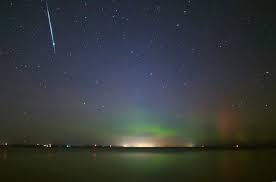For those of us in the Northern Hemisphere, the start of autumn means a few things: chillier days, longer nights, and lots of shooting stars.
Source: Travel Leisure
At this time of year, there are several meteor showers, and your chances of seeing shooting stars are even higher in early November, as two Taurid meteor showers peak. We’re not talking blink-and-you-missed-it streaks, but bright fireballs, so get ready to bundle up and head outside to see some shooting stars this week from the Southern Taurids and Northern Taurids.
Why are they called Taurids?
The name “Taurids” comes from these meteor showers’ association with the constellation of Taurus, the bull. However, the physical connection is nothing more than an illusion. The Taurus constellation rises in the east after dusk. A prominent winter constellation found between Aries and Gemini, it’s easiest to see at this time of year by finding the bright star cluster of Pleiades (also known as the Seven Stars) and looking down towards the V-shaped Hyades star cluster, which doubles as the head of Taurus the bull. The bull’s eye is the red star Aldebaran.
If you see a shooting star this week—and they can appear anywhere in the night sky—trace its trajectory back and, if it comes from the direction of Taurus, you saw a Taurid meteor. Astronomers call this spot where the meteor appears to originate the “radiant point.”

What are the Taurid meteor showers?
Most meteor showers are caused by comets, which leave streams of dust and particle fragments in the inner solar system when they swing around the sun and return to deep space. If the comet’s orbit loops around the sun and through Earth’s orbital path around the sun, it will leave particles for Earth to “crash” into at some point. As Earth’s atmosphere collides with these particles, they heat up, which causes them to light up as they discharge energy and burn up to become meteors.
The Southern Taurids have a pretty dispersed stream, since this meteor shower is active from September 10 to November 20, 2019. The Northern Taurids, which come from a separate stream, are active from October 20 to December 10, 2019. This week, the two Taurids will overlap.
When is the best time to see the Taurids?
Early November, when the two meteor showers are overlapping, you can expect to see about 5 to 10 shooting stars per hour. That may not sound like many, but what the Southern and Northern Taurids lack in quantity, they can make up for in quality. Both the Southern and Northern Taurids are dripping with bright fireballs that can be an astonishing sight, so they are well worth the wait.
Most meteor showers have a ‘peak’ night when the most shooting stars will be visible. The Southern Taurids technically peaked in October, but they are still predicted to feature fireballs early in November. For the Northern Taurids, the peak is at 18:00 EST on November 12, 2019. However, that’s just before a full moon (which will make them harder to see), so start looking earlier in November when the skies are darkest and the two meteor showers both happening.
What comet causes the Southern and Northern Taurids meteor showers?
The Southern Taurids are caused by Enke’s Comet, which orbits the sun every three or so years and is the most common visiting bright comet that we know of. It was discovered in 1786. The Northern Taurids are probably caused by an asteroid called 2004 TG10, which may have broken off from Enke’s Comet.
When is the next major meteor shower?
Next up is the Leonids, named after their radiant point in the constellation Leo. Active from November 6 through November 30 in 2019, the Leonids will peak around midnight on November 16-17 when about 15 shooting stars per hour—mostly bright meteors with vibrant “trains” — could be visible.
Source: Travel Leisure

































Leave a Comment
You must be logged in to post a comment.